Welcome to our blog for the Plastic in the Pacific Crusade. If you missed the earlier editions please use the category search in the footer to go back and read them. They are listed under Plastic in the Pacific. Over the coming year we will be writing regularly of our adventures and what we are seeing. In this article we cross the Atlantic Ocean.
An Atlantic Crossing is a huge bucket list tick for both Annika & I. Neither of us had done it before and it would be the furthest from land either of us have ever been. Only one other crossing on our route home will be longer, the Galapagos to Marquesas which stands at 3,300nm. This leg would be 2,600nm as the crow flies but the traditional route will always take you almost to the Verde Islands so you end up sailing closer to 3,000nm anyway.
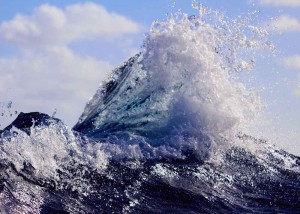 Our departure would be very early in the season, in fact we would be sailing into the Caribbean still in hurricane season. After a lot of research I had found that the later the season goes on, the further north the hurricanes are. In fact they usually happen above 25 degrees north and we were going to be sailing into 12 degrees north so a long way from where the traditional hurricane patterns have them. The main thing was to avoid the building of them in the Atlantic, but with good forecasting from Predictwind, and routing from them and Maxesa, we knew we had the ability to sail around anything that developed, or maybe even use it to our advantage.
Our departure would be very early in the season, in fact we would be sailing into the Caribbean still in hurricane season. After a lot of research I had found that the later the season goes on, the further north the hurricanes are. In fact they usually happen above 25 degrees north and we were going to be sailing into 12 degrees north so a long way from where the traditional hurricane patterns have them. The main thing was to avoid the building of them in the Atlantic, but with good forecasting from Predictwind, and routing from them and Maxesa, we knew we had the ability to sail around anything that developed, or maybe even use it to our advantage.
The forecast before we left showed us heading within 200nm of the Verde Islands. The forecast shows a time period of 16 days on Maxsea and 14 days on Predictwind. Both showed that we would take longer than that but showed consistent winds of up to 20 knots, nothing over. With limited crew, we weren’t going to race the leg, it was about making it. The spinnaker would not fly at night and if it got too windy it would come down even during the day. We had time on our side, we didn’t have funds to fix too much so our plan was simple, sail well within the boats capabilities, even if it took longer.
Taking all this into account, I still had in my head that I wanted to complete the leg in under 20 days. With the unknown of our guests ability offshore, the backup plan would be to divert to Cabo Verde but we really wanted to avoid that. Getting to Barbados was our highest priority, and getting there in one piece would be crucial to our campaign in the Pacific.
Departing Puerto de Mogan at 1140, having done a final provision run and a walk, we steamed out of the marina and it was a glass out. Out to sea we could see a wind line and getting to that was our first mission. With 270 liters of diesel on board, we couldn’t afford to motor for long periods of time. We needed our fuel for charging and emergencies. After just 20 minutes we picked up the breeze and before you knew it we had actually reefed down both headsail and mainsail. We were flying along at 7+ knots on a south-westerly direction in 15-18 knots of wind. The first night the wind dropped back to 10 knots and we were doing 4 knots more to the south but we had just begun and were in no hurry. We also had plenty of patience this early on in the trip.
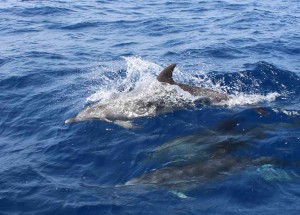 Both Annika and I are commercial skippers and have run plenty of tours in the Whitsundays with backpackers. One of the things skippers always do is compare ‘stupid questions’ that guests have asked. Some of the common ones would be ‘Where are the dolphins?’ or ‘Where are the whales?’ So when our guest asks where the whales and dolphins are, we had to have a little laugh. This was a 52 year old lady. Surely she knows that dolphins and whales have a mind of their own and they will come if you are lucky. It was funny at first but after a couple of days, you kind of wonder what is going on.
Both Annika and I are commercial skippers and have run plenty of tours in the Whitsundays with backpackers. One of the things skippers always do is compare ‘stupid questions’ that guests have asked. Some of the common ones would be ‘Where are the dolphins?’ or ‘Where are the whales?’ So when our guest asks where the whales and dolphins are, we had to have a little laugh. This was a 52 year old lady. Surely she knows that dolphins and whales have a mind of their own and they will come if you are lucky. It was funny at first but after a couple of days, you kind of wonder what is going on.
Now when you have a possible three week journey, one of the keys is making your food last. It’s a simple equation, you see what you’ve got and space it out. We had plenty of spare food for emergencies but fresh food is a critical thing. Apples and oranges for instance will last most of the way and we had plenty, well so we thought. When our guest decides to eat 4 apples on day one, well we had to say something. It became an ongoing saga, she just didn’t understand that you have to space out your food. If you eat it all in the first week you will have nothing for the last two weeks. I’m not going to harp on about it much longer but basically Zuzana had done no research on sailing, no research on sailing long distances and hadn’t even looked into Barbados, our destination, other than to know she didn’t need a visa. Annika was a bit surprised when she asked ‘Are there black people there?’
Anyway, on with the sailing story. I’ve sailed long passages before and my shift was always by myself. Seeing Annika on the change over of watches, we ran 4 hours on, 4 hours off, was great as when I sailed around Australia solo, I had no one to take over the watch other than the auto-pilot and computers. Day two we knew would be the lightest day we would have to endure as far as the forecast was concerned so waking up to a glass out was kind of expected. I knew we could afford a bit of fuel to get south to clear the band of no wind so we did that. We motored for 9 hours on that second day and totally against our plans, we ran the spinnaker at night. It was a perfect night and cruising at 5-6 knots under kite with clear skies was awesome.
 Day 3 saw a lot of sunny our spinnaker and day 4 saw none at all as the wind came in at 15-23 knots so we could get our speed without the spinnaker. All the time we are heading South-South-West towards the Verde’s. By day 5 we were in the trades of 15-20 knots and the only time the wind moved was when a cloud came over. The only time we used the engine was to charge batteries and we would have it in neutral as we didn’t need the extra speed that just made things uncomfortable. By day 6 we were starting to see more clouds and when our guest wakes up in the morning and sees that it wasn’t sunny, her expression was priceless. She constantly told us that she came from a country where there was little sun and that the sun was her energy. So clouds made her unhappy inside. Meanwhile Annika and I are thriving on the wind and the starry nights, with shooting stars everywhere.
Day 3 saw a lot of sunny our spinnaker and day 4 saw none at all as the wind came in at 15-23 knots so we could get our speed without the spinnaker. All the time we are heading South-South-West towards the Verde’s. By day 5 we were in the trades of 15-20 knots and the only time the wind moved was when a cloud came over. The only time we used the engine was to charge batteries and we would have it in neutral as we didn’t need the extra speed that just made things uncomfortable. By day 6 we were starting to see more clouds and when our guest wakes up in the morning and sees that it wasn’t sunny, her expression was priceless. She constantly told us that she came from a country where there was little sun and that the sun was her energy. So clouds made her unhappy inside. Meanwhile Annika and I are thriving on the wind and the starry nights, with shooting stars everywhere.
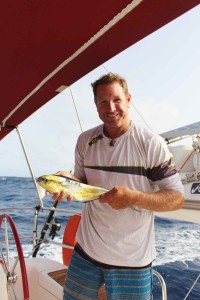 Our fishing attempts were going very badly until finally I caught a juvenile dolphin fish. The poor thing was starving it look like, but it was a good size to feed three so it didn’t go back. It would prove the only fish we would land all trip. We had lots of bites and at one stage something took a lure and snapped the line with the empty line snapping back past the cockpit. Not bad for 80 pound line. Whatever it was took off at a great rate of knots and the line didn’t hold. Towards the end of the trip we gave up due to catching more weed that anything else. Every 10 minutes you’d have to pull weed off the hooks so it wasn’t worth it.
Our fishing attempts were going very badly until finally I caught a juvenile dolphin fish. The poor thing was starving it look like, but it was a good size to feed three so it didn’t go back. It would prove the only fish we would land all trip. We had lots of bites and at one stage something took a lure and snapped the line with the empty line snapping back past the cockpit. Not bad for 80 pound line. Whatever it was took off at a great rate of knots and the line didn’t hold. Towards the end of the trip we gave up due to catching more weed that anything else. Every 10 minutes you’d have to pull weed off the hooks so it wasn’t worth it.
By week two, you start getting tired. People are not meant to sleep 4 hours on, 4 hours off and you don’t really get 4 hours. Maybe a kite needs to be launched or pulled in, maybe a meal falls in the middle of your off watch, you just don’t get the rest you normally would and when it is your turn on watch you have plenty do to most of the time, making sure the navigation is good, the sails are trimmed etc. So as you get more and more tired you start missing things, or you do stupid stuff. So one day I’m on watch and get so frustrated with the sea state that an hour into my watch I wake Annika up and say we need to gybe. So we furl the headsail away and decide that due to 15-20 knots, we would actually do a chicken gybe (turn the boat through the eye of the wind rather than have the boom fly overhead in a conventional gybe.) So Annika takes the helm and I control the main. Just past half way through, with no return available, we realise that we hadn’t pulled the fishing line in. So next thing we have sailed over the top of it and of course it gets hooked. We are so worried we have it in the prop as we can’t pull it back on deck that we pull all the sails down so I can jump into the water and see what’s going on. We’re still doing 3 knots under poles so Annika had to turn the boat into the wind to stop it. I see that it is actually caught in the small gap at the front of the keel where it meets the hull. The silicone seal is gone and it has found its way into the slot. I dive under and try to grab the lure but succeed in only getting the hooks caught at the base of my thumb. The boat is moving up and down in the swells and still moving forward. For a fleeting moment I picture myself being stuck under a boat by a stupid fishing lure. Couldn’t catch fish but could catch myself!!!! I manage to free myself and on the second attempt I pull the lure free. In hindsight, pulling the line around the bow to the other side would have done the same thing, and a lot safer. Sleep deprivation is not good for decision making.
The daily routine really starts to grind on you and you read a lot, you stare at the stars a lot and you get annoyed at stupid things, like the wind dropping 2 knots and changing direction. In the middle of the ocean I really thought the wind would be more consistent in strength and direction but every cloud effected both. It would mean changing course and sometimes gybing or reducing sail. Some days you would spend a whole watch adjusting the auto-pilot to the wind direction. It would be really frustrating, especially at night. We had no moon at all for most of the trip as it was up through the daytime so nights would be dark, especially when you have clouds. One day we were running ‘Sunny’. Annika was on watch and I was sleeping. All I heard was ‘Thommo’ yelled, so I bolt out of bed and onto deck. Annika thought the spinnaker was coming down as she was watching the top of the mast when the shackle holding the block at the top of the mast broke. This meant the spinnaker dropped 2m from the top but held at the sheave. Again, lucky for us we had a sock so we socked the spinnaker and lowered it to the deck. Then it was time for Annika to go back up the mast again. This time we didn’t have Siv with us who knew how to tail a line. So we tried to explain to Zuzana what she had to do and how important it was to keep the line tight through the jammer so Annika didn’t bounce or fall.
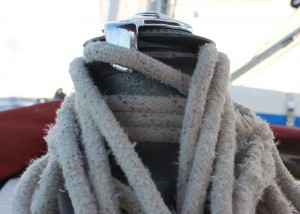 You would think that by the end of 2 weeks at sea, someone would know something about sailing but Zuzana had not shown any interest in learning how to sail. It seemed to both of us that she was on a 5 star cruise, well that’s what she wanted anyway. She would sit and sunbake and make her own food, never cooked or helped clean, it was really frustrating for both Annika & I and as we entered our last week we couldn’t wait to get to Barbados to get her off the boat. We needed the cash, that’s why we took her with us but I will still today claim it as the hardest money I’ve ever earnt.
You would think that by the end of 2 weeks at sea, someone would know something about sailing but Zuzana had not shown any interest in learning how to sail. It seemed to both of us that she was on a 5 star cruise, well that’s what she wanted anyway. She would sit and sunbake and make her own food, never cooked or helped clean, it was really frustrating for both Annika & I and as we entered our last week we couldn’t wait to get to Barbados to get her off the boat. We needed the cash, that’s why we took her with us but I will still today claim it as the hardest money I’ve ever earnt.
Anyway, Annika goes up the mast and replaces the shackle and we can relaunch ‘Sunny’ once again. By this stage, as I mentioned before, we were going through lots of weed. Even the prop was getting tangled so every day I would dive under the boat and free anything caught. You could tell in the aft cabins when steaming if something was on the prop as the whole boat would shudder as the prop was out of balance. Jumping in the water was never an issue though, as the color of the water in the middle of the ocean is the most spectacular color that those who never go there will never understand. The clarity and the sun rays streaming through the water are unbelievable, something that makes ocean sailing so special. You also get joined by lots of birds and even dragonflies on our trip. It is a magical place the middle of the ocean.
Without a moon the starry nights would see countless shooting stars and you find yourself making lots of wishes. You almost run out of wishes there are that many. But my wishes would be about a safe passage and winds to take us direct to Barbados, rather than the round-a-bout way we were going. Every time we downloaded a new forecast and ran the routing (every 6 hours) the course would show that we needed to go north before the final run into Barbados. Just when we think we’ve got 6 hours before the final gybe, the routing takes us further north so our distance to goal isn’t decreasing at a good rate. After 17 days at sea, all you want is for the last 3-4 days to fly by so you can get there, feel land, drink beer/rum/wine and have fresh food again. Tomatoes were gone, lettuce gone, cucumber gone. We were down to tinned food and avocados which somehow we managed to keep going right till the second last day.
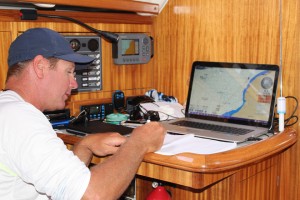 My original goal of under 20 days was gone, we had moved that to under 3 weeks. To turn up within 3 weeks became the new goal and as we entered the last 150nm, I checked the fuel levels to find we had around 100 liters left plus the 40 liters in the jerry cans. So we knew we could steam all the way in if we wanted to, so as the winds got light that’s exactly what we did. I have a really bad habit of arriving at places in the middle of the night. It started a long time ago and for some reason when transiting long distance, no matter how well I plan it, I seem to arrive at a place around 2-3am. So as night falls on our last full day, we start to see the lights of Barbados. It is a welcome sight to finally see land and we are all getting really excited. We head around the southern end of Barbados as that is closest to Carlisle Bay and the main port where we can check in. We arrived out the front of the yacht club at 0245 and picked up a mooring. There was a swell rolling around the point so it wasn’t totally still but with the engine off and the sails away, we had arrived in Barbados to the sounds of the local nightclub playing R&B reggae. Zuzana hadn’t come on deck for the arrival but Annika and I celebrated with a drink.
My original goal of under 20 days was gone, we had moved that to under 3 weeks. To turn up within 3 weeks became the new goal and as we entered the last 150nm, I checked the fuel levels to find we had around 100 liters left plus the 40 liters in the jerry cans. So we knew we could steam all the way in if we wanted to, so as the winds got light that’s exactly what we did. I have a really bad habit of arriving at places in the middle of the night. It started a long time ago and for some reason when transiting long distance, no matter how well I plan it, I seem to arrive at a place around 2-3am. So as night falls on our last full day, we start to see the lights of Barbados. It is a welcome sight to finally see land and we are all getting really excited. We head around the southern end of Barbados as that is closest to Carlisle Bay and the main port where we can check in. We arrived out the front of the yacht club at 0245 and picked up a mooring. There was a swell rolling around the point so it wasn’t totally still but with the engine off and the sails away, we had arrived in Barbados to the sounds of the local nightclub playing R&B reggae. Zuzana hadn’t come on deck for the arrival but Annika and I celebrated with a drink.
After 20 days, 15hours and 5 minutes we had ticked a huge life box, we had crossed the Atlantic. Not only had we crossed the Atlantic, we had done it on our own yacht, short handed and the only damage was a spinnaker halyard we knew was on its way out, and a few lost lures. 86 hours had been put on the engine and most of them at charging revs so the total fuel consumption was only 140 liters. We’d also used 15 liters of unleaded in the generator so we could run the watermaker to fill tanks on 4 occasions.
When we look back on it know, it was the smoothest crossing one could hope for. No winds over 20 knots made for pleasant sailing, very little under 10 knots either. The boat travelled 2,983nm through the water so it wasn’t so bad afterall. In the end, it had been perfect. The best part was we were now in Barbados, the home of Mount Gay Rum, our favorite rum.
In our next edition we explore Barbados above and below the water.
Ocean Crusaders are out to change the way people treat our oceans. Our online education program is free to download at www.OceanCrusaders.org/education where children can learn of the issues our oceans are facing and how they can make a difference. The Plastic in the Pacific Crusade is about educating the South Pacific Islands, finding out what is happening in these islands and updating our programs. You can join us in the Pacific and see for yourself what we do.
Ocean Crusaders Plastic in the Pacific Crusade is proudly supported by: Cressi Dive Gear, Gill Marine, Keen Footwear Australia, Barz Optics Sunglasses, Maxsea Navigation Software, Digital Diver Cairns, LED Dive Lights Australia, Boat Names Australia & Predictwind Weather
[cincopa AUPAaFdJ_80-]
